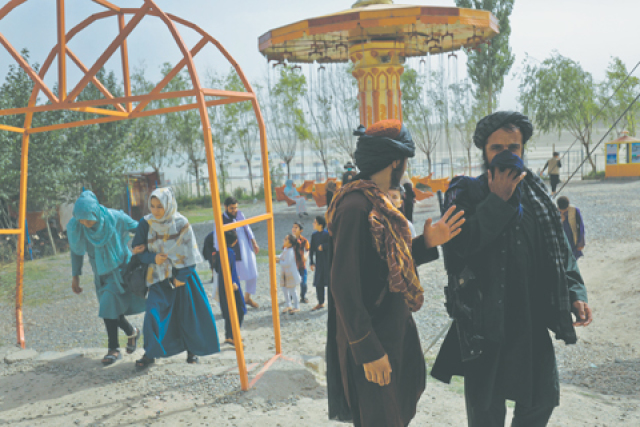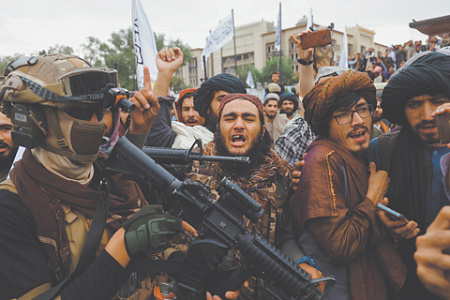Resistance to the regime is growing and entails new threats to the worldFor more than two decades, terrorist and extremist groups of all stripes have been clashing on the territory of Afghanistan.
These formations not only continue to exist, but also find opportunities to consolidate their forces by planning, organizing and carrying out terrorist attacks in the region and beyond.
THREE CATEGORIES OF GROUPINGSThese include the following three categories:
1. Pakistani extremist groups
Currently, there are officially 10 to 14 Pakistani extremist groups, among the largest of them are Tehrik-e-Taliban Pakistan (TTP, banned in the Russian Federation), Lashkar-e-Taiba (LeT, banned in the Russian Federation), Sepah-e-Sahaba Pakistan (SSP), "Jaish-e-Mohammad" (JeM), "Al-Badr", etc.
All of them are ready to take advantage of the current unfavorable situation. At the same time, with the exception of some factions within the TTP, all other extremist groups in Pakistan have traditionally been allies of the Taliban and, apparently, remain so to this day.
2. Regional terrorist groups
The main regional extremist organizations are present on the territory of Afghanistan. Among them are the Islamic Movement of East Turkestan (IDVT), the Islamic Movement of Uzbekistan (IMU, banned in the Russian Federation) and the Tajik Jamaat Ansarullah.
These groups have been allied with the Taliban for many years and seek to use the Afghan territory as a transit point and a training ground in order to then penetrate into Central Asia, China and Russia to carry out attacks.
3. Global terrorist groups
There are three main groups of a global nature operating in Afghanistan. These include Al-Qaeda (banned in the Russian Federation), Al-Qaeda in the Indian Subcontinent (AKIS, banned in the Russian Federation) and the Islamic State in Khorasan province (IG-Khorasan, banned in the Russian Federation).
Of these three organizations, IG-Khorasan is currently the largest and strongest. She managed to survive despite devastating attacks by Afghan and international security forces for many years.
The previous Afghan regime and the troops of the international coalition stated that in the period from 2015 to 2020, more than 13 thousand militants of this group were liquidated or captured, including five emirs in a row. Nevertheless, IG-Khorasan has demonstrated amazing resilience, having managed to make up for lost strength, expand its geographical presence and increase the number and intensity of operations.
The IG-Khorasan attack on the capital's airport in August 2021 and the bombings in Kabul, Jalalabad, Kandahar, Kunduz, Herat and other provinces in recent months demonstrate that the group has intentions to increase the number and scale of operations. Apparently, IG-Khorasan will continue to unite many regional groups, including some militants from the IDVT, IMU and Jamaat Ansarullah, as well as defectors from the Taliban – either under its own flag or by some other agreement.
Al-Qaeda and its subsidiary organization, AKIS, also appear to be expanding their presence and scale of operations in Afghanistan, albeit in the role of instructors and consultants. In addition to setting up training camps for Afghan and foreign terrorists in the south of the country, the organization is trying to establish relations with IS-Khorasan cells in order to eventually create a united front for global jihad.
Al-Qaeda is also seeking to infiltrate northern Afghanistan, especially Badakhshan province, to train and unite members of terrorist groups from Central Asian countries.
FIVE TYPES OF ATTACKSThe composition of foreign terrorist and extremist groups in Afghanistan illustrates the wide range of threats they pose to the region and the world.
These organizations may seek to expand the field of activity and organize the preparation of terrorist attacks outside Afghanistan, using its territory as a refuge. Given the geographical proximity, the countries of the region, including the Central Asian states, China, Russia and India, may become the main targets, followed by Europe and North America.
Threats can be presented in at least five ways:
1. Coordinated attacks by participants
Terrorist groups can plan, organize, coordinate and carry out attacks around the world, using Afghan territory as a refuge and using all the tools that are now at their disposal: landfills, volunteers, financial resources, access to weapons and explosives, communications, etc.
These attacks can be carried out by members of groups, planned and organized by groups inside Afghanistan and their cells around the world.
2. Attacks by lone conspirators
Terrorist groups on the territory of Afghanistan can contribute to the preparation of attacks carried out alone by individuals associated with groups around the world. Assistance is provided to them by preparing the necessary means, weapons and explosives, selecting targets and monitoring them – all this is one of the main components of terrorism. Without shelters and resources provided by terrorist groups, conducting such activities is extremely difficult for individuals.
3. Attacks of affiliated singles

The Taliban who came to power restricted the rights of women, seeking to plunge them deeper into the problems of family and children. Photo by Reuters Terrorist groups present on the territory of Afghanistan can send their affiliated members to various target points, outlining to them in general terms the concept of terrorist attacks that individuals plan, organize and carry out independently, without receiving any additional assistance from groups.
Such attacks are difficult to predict and prevent, since individual attackers often act independently, with little or no coordination with their groups. Again, finding extremist organizations in safe havens is crucial for identifying, recruiting, radicalizing and motivating individuals.
4. Attacks of "lone wolves"
Terrorist groups in Afghanistan can inspire people who, without being associated with them, plan, organize and carry out terrorist attacks around the world.
A "lone wolf" is a terrorist who commits armed attacks alone, for ideological, social, psychological or even pathological reasons, without obvious ties to any group and without direct connection to an extremist network on the ground.
There are two types of "lone wolves", although their characteristics may partially coincide.
The first type is caused by psychological factors: such people suffer from problems in the family, at work or in society, and this forces them to project their negative energy on other people. In order to alleviate grievances that, in their opinion, lead to internal dissatisfaction, they take revenge on their surroundings until their problems become known, while at the same time striving for fame.
The second type of "lone wolf" is more common and more dangerous because it is driven by ideological or nationalistic sentiments.
The concept of a "lone wolf" was first used after affiliated militants of Al-Qaeda and the Islamic State (IS, banned in the Russian Federation) carried out a series of deadly attacks on civilians in Europe and the United States.
The so-called victory of the Taliban over the United States, NATO and the Islamic Republic of Afghanistan has already given an ideological impetus to Islamist groups and individuals around the world, which indicates the possibility of increasing radicalism. The massive presence of regional and global terrorist groups along with the Taliban in Afghanistan is highly likely to continue to generate Islamic extremism in Central Asian countries, among the Muslim population of China, as well as marginalized Muslim communities in Europe and the United States. This could potentially lead to the strengthening of old and the emergence of new forms of terrorism.
RESISTANCE TO THE TALIBAN REGIMEAt the same time, it should be noted that at the moment armed resistance to the Taliban is growing in Afghanistan.
To date, at least 14 groups have emerged, including: "National Resistance Front", "Freedom Front of Afghanistan", "Supreme Council of Resistance", "Freedom Uprising" and others, many of which are already fighting against the Taliban in various parts of the country.
Although these formations are currently small, when united, they may well turn into a large and serious resistance movement. This is due to the fact that they have all the means and prerequisites necessary for the emergence of a large-scale resistance movement. Mass discontent with the policy pursued by the Taliban is growing, the state of the economy is deteriorating, the rights of women and ethno-religious minorities are being ignored. In addition, Afghanistan is overflowing with weapons and ammunition.
Earlier, the media reported that new field commanders began to declare themselves in Parvan, Kapis, Jauzjan, Faryab, Sari-Pool and other areas. Prominent figures such as General Abdul-Rashid Dostum, Atta Mohammad Nur, Mohammad Mohakkik, Karim Khalili and others, as well as new and young representatives of the Tajik, Hazara and Uzbek communities, who are in Uzbekistan, will play an important role in the nascent resistance.
One of the most striking examples is Ahmad Masood and his "National Resistance Front". It is also reported that the Fatimiyun brigade, consisting of Hazaras, has already begun to reorganize for the war against the Taliban.
Thus, the emergence of anti-Taliban armed resistance can be used as an instrument of pressure on the leadership of the movement to soften its position on a number of political and social issues.
However, the escalation of the armed conflict in Afghanistan does not meet the interests of the region and the whole world, as it will lead to further instability and escalation of violence in the country. The deterioration of the domestic political situation can cause even greater waves of migration, provoke the growth of organized criminal activity and the strengthening of the terrorist threat.
Larisa ShashokLarisa Aleksandrovna Shashok is a teacher at MGIMO (U) of the Ministry of Foreign Affairs of the Russian Federation.

